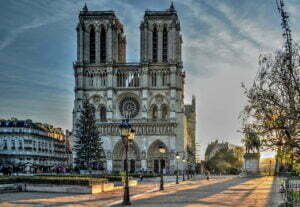Amiens Cathedral, also known as Cathédrale Notre-Dame d’Amiens, is a stunning Gothic cathedral located in the city of Amiens, which is the capital of the Somme department in the Picardy region of France. Here are some historical facts about the cathedral.
Amiens Cathedral, France
1. Location: Amiens Cathedral, situated in the Hauts-de-France region, specifically in the Department of the Somme, is a truly monumental architectural masterpiece. It ranks among the largest churches in France and stands as one of the most complete examples of 13th-century Gothic architecture.
What makes it particularly remarkable is the meticulous coherence of its design, characterized by a perfectly symmetrical layout of the nave and choir on either side of the transept, a breathtaking three-tier interior elevation, a pioneering structural lightness that heralds a new era in the conquest of luminosity, an opulent array of sculpted ornamentation, and stunning stained glass. All these elements combined make it a truly outstanding representation of medieval architecture.
The construction of Amiens Cathedral was completed in less than a century, characterized by a high degree of continuity among the master builders who worked on it. The initial architect, Robert de Luzarches, laid the foundation from 1220 to 1223, and this endeavor continued with his assistant, Thomas de Cormont, from 1223 to 1228.
The legacy was then carried forward by Robert de Luzarches’ son, Renaud, who oversaw construction from 1228 to 1298. This continuity of master builders is a testament to the unity of the cathedral’s conception and realization, showcasing the values associated with this exceptionally well-preserved Gothic cathedral.
2. Christianity in Amiens: While the architectural brilliance of Amiens Cathedral is truly remarkable, it’s important to recognize its historical and religious significance. The presence of Christianity in Amiens dates back to the third century A.D., with the arrival of Christian martyrs Firmin the Martyr and Firmin the Confessor.
Later, in 334, Saint Martin, an iconic figure in the Christian faith, was baptized in Amiens, and the church has a history filled with devout activities, including baptisms and episcopal participation in important religious councils. Moreover, the cathedral hosted the wedding of King Philip II of France in 1193, further emphasizing its religious importance in the medieval period.
Despite facing several challenges throughout its history, including fires, wars, and neglect, Amiens Cathedral remains a beacon of architectural and historical significance. It has endured the test of time and stands as a testament to the ingenious design and meticulous craftsmanship of its creators, making it a must-visit destination for those seeking to immerse themselves in the rich history and awe-inspiring architectural beauty of the Gothic era.
Amiens Cathedral History
3. Construction and Origins: Amiens Cathedral, formally known as Cathédrale Notre-Dame d’Amiens, is a masterpiece of French Gothic architecture. Its construction began in 1220, during the reign of King Louis VIII, and was largely completed in the early 14th century.
The cathedral was built on the site of a previous church that had been destroyed by fire. The cornerstone was laid by Bishop Evrard de Fouilloy, and the construction was overseen by Robert de Luzarches, who served as the first architect of the cathedral.
4. Role of Pilgrimages: Amiens Cathedral was built to accommodate a growing number of pilgrims who visited the city to venerate what was believed to be the head of John the Baptist. The cathedral was designed to provide ample space for large crowds of pilgrims and became a significant pilgrimage site in the Middle Ages. The cathedral’s ample interior spaces and an array of chapels served the practical needs of accommodating religious processions and gatherings.
5. Devastation and Restoration: Throughout its history, Amiens Cathedral faced several challenges, including fires, wars, and neglect. During World War I, the cathedral suffered minor damage, and afterward, extensive restoration efforts were undertaken to repair and preserve the structure. These restoration projects aimed to safeguard the cathedral’s architectural integrity and the exquisite artwork within.
6. UNESCO World Heritage: In 1981, Amiens Cathedral was designated as a UNESCO World Heritage Site. It was recognized for its cultural and architectural significance, as it represents an exceptional example of the artistic and engineering achievements of the High Gothic period. The UNESCO designation has played a role in raising awareness about the importance of preserving this historic and architectural gem.
Amiens Cathedral continues to be a symbol of the city’s rich history and is admired for its architectural splendor and cultural significance. It stands as a testament to the artistic and engineering prowess of its creators and the enduring legacy of Gothic architecture in France.
Amiens Cathedral Architecture
7. Gothic Splendor: Amiens Cathedral is a prime example of high Gothic architecture, celebrated for its breathtaking beauty and the precision of its design. It showcases many of the architectural innovations that became characteristic of this style during the 13th century.
High Gothic architecture is known for its soaring height, intricate detailing, and use of structural advancements that allowed for larger, more open interior spaces. The cathedral is particularly notable for its emphasis on verticality, which is achieved through features like the pointed arches, ribbed vaults, and soaring pinnacles.
8. Exterior and Façade: The cathedral’s exterior is adorned with several distinctive features typical of Gothic architecture. The façade is dominated by three deep portals that are richly decorated with sculptural elements and statuary. The cathedral boasts a wealth of sculptures, including numerous biblical figures, saints, and allegorical representations.
The use of pointed arches and ribbed vaults inside the cathedral not only contributes to its architectural splendor but also serves the practical purpose of directing the weight of the structure downward and outwards, reducing the need for thick supporting walls and allowing for expansive stained glass windows.
9. Stained Glass: One of the most striking architectural features of Amiens Cathedral is its remarkable stained glass. The windows of the cathedral are renowned for their size and vibrancy. They are filled with intricate, vibrant scenes from the Bible, portraying religious narratives in brilliant color and detail. The stained glass in the cathedral serves a dual purpose: it enhances the spiritual experience of the space and bathes the interior with an otherworldly, ethereal light.
10. Height and Dimensions: The sheer height of the cathedral is awe-inspiring. It reaches approximately 42 meters (138 feet) at the nave’s highest point, making it one of the tallest complete cathedrals in France. The nave itself is nearly 43 meters (141 feet) in height. This vertical emphasis, along with the ribbed vaults, not only creates a sense of grandeur but also distributes the weight of the roof and upper structures in a way that allows for the expansive use of glass in the windows.
11. Flying Buttresses: To support the vast expanses of glass and the cathedral’s walls, flying buttresses were employed. These graceful, arched structures extend outward from the exterior of the cathedral, helping to counteract the immense weight of the stone and prevent the walls from collapsing under their own weight. This architectural innovation allowed for the creation of expansive, luminous interiors while maintaining structural stability.
Amiens Cathedral’s architecture represents the pinnacle of Gothic achievement. Its design and structural elements are not only aesthetically captivating but also served functional and engineering purposes that were groundbreaking for the time. The cathedral remains a testament to the profound ingenuity and craftsmanship of the architects and builders of the High Gothic era.
Cathédrale d’Amiens Recap
The Amiens Cathedral is one of the most impressive examples of high Gothic architecture and is recognized as one of the largest cathedrals in France.
- Architectural Grandeur: Amiens Cathedral is celebrated for its architectural grandeur. It is often regarded as one of the finest examples of French Gothic architecture. The construction of the cathedral began in 1220 and was largely completed by the early 14th century.
- Stunning Facade: The cathedral’s west facade features an intricate sculptural program that depicts scenes from the Bible and various allegorical figures. The facade is dominated by three deep portals, adorned with countless statues and sculptures.
- Rose Windows: The cathedral boasts a remarkable set of stained glass windows, including the famous Great Rose Window, which is among the largest and most beautiful rose windows of any Gothic cathedral.
- Interior Magnificence: Inside, visitors can admire the cathedral’s impressive nave, soaring vaulted ceilings, and an abundance of stained glass. The labyrinth on the floor was used in medieval times for religious processions.
- Height Records: Amiens Cathedral held the title of the tallest complete cathedral in France until the completion of Beauvais Cathedral. Nevertheless, it remains one of the highest and most complete cathedrals in the country.
- UNESCO World Heritage: In 1981, Amiens Cathedral was recognized as a UNESCO World Heritage Site, emphasizing its cultural and architectural significance.
- Festivals and Events: The cathedral plays a central role in local culture and hosts a variety of events and festivals, including light and sound shows that illuminate its facade.
- Spiritual Significance: While a tourist attraction, the cathedral is still a place of worship, and it holds religious services regularly.
Amiens Cathedral is an iconic landmark in France and is admired for its architectural and artistic beauty. It remains an enduring symbol of the rich history and cultural heritage of the Hauts-de-France region.





